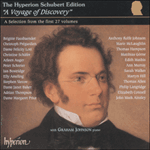
Welcome to Hyperion Records, an independent British classical label devoted to presenting high-quality recordings of music of all styles and from all periods from the twelfth century to the twenty-first.
Hyperion offers both CDs, and downloads in a number of formats. The site is also available in several languages.
Please use the dropdown buttons to set your preferred options, or use the checkbox to accept the defaults.

Schubert set this poem no fewer than six times. The first setting exists in two versions (A flat major, D310A, and F major, D310B) which date from 18 October 1815. The second, third (1816) and fourth (1819) settings are on this disc. The last two settings, one a duet – obedient to Goethe's description – and the other the famous solo song, belong to 1826 and were published as part of Op 62.
For the second setting the composer has not yet settled on the key of A minor for his Mignon; this was already a feature of his Harper songs (and the relationship of Mignon and the Harper as father and daughter makes it appropriate that they should share the DNA of tonality) and it was to be the key of the last two solo settings, including of course the famous song with a mournful and introverted melody in 6/8 which Schubertians associate with these words. Nevertheless, in this D minor setting (the first in a minor key) we can recognise a number of the features of the famous Mignon song (D877 No 4): the time signature is 6/8 for the first time; flowing triplets support most of the vocal line; the immobile staccato chords which support the line 'Ach! der mich liebt und kennt' are similar to those in the final setting; the section beginning 'es schwindelt mir' is supported by excited demisemiquavers (already tentatively present in D310B), and the phrase 'es brennt mein Eingeweide' is repeated. It is as if we can see the outline of the song we know so well taking shape strongly in the composer's mind. Indeed, at the reprise of 'Nur wer die Sehnsucht kennt' Schubert hits on the exact rhythm (with a two-semiquaver shudder on 'Sehnsucht') in which he was to set those famous words for the last time.
Despite this impression of 'work in progress' the song is effective and moving in its own right. The tessitura is much is much higher than D877 No 4 so the effect is more operatic, less introverted. In her two 1816 manifestations Mignon is made to take centre stage in a way that is perhaps contrary to her waif-like character. It is the underplayed yet heart-breaking nature of the 1826 settings which renders them definitive. A beautiful touch, unique to this setting, is the repeat of the words 'Ach! der mich liebt und kennt' (not repeated in any of the other solo songs, only the duet setting); we hear it for the first time in C major, and for the second in B major. This semitone slip downwards is a mournful dislocation which implies great distance and it admirably serves the sense of the words 'in der Weite.'
from notes by Graham Johnson © 1995
 Schubert: The Complete Songs Schubert: The Complete Songs‘This would have been a massive project for even the biggest international label, but from a small independent … it is a miracle. An ideal Christ ... ‘Please give me the complete Hyperion Schubert songs set—all 40 discs—and, in the next life, I promise I'll "re-gift" it to Schubert himself … fo ...» More |
 Schubert: An introduction to The Hyperion Schubert Edition Schubert: An introduction to The Hyperion Schubert Edition'Irresistible!' (BBC Music Magazine) 'A delightful sampler' (The Penguin Guide to Compact Discs)» More |

